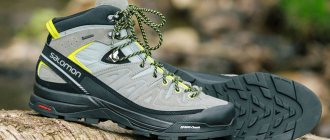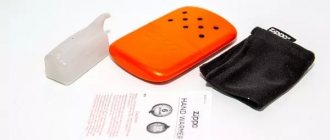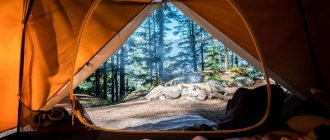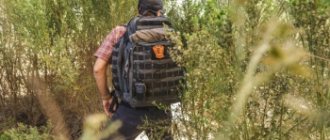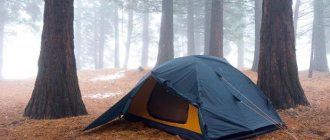How to wash in ponds
The bodies of water that you will encounter in the mountains - rivers, streams and lakes - have one feature: the water temperature in them tends to zero. The maximum that you will have time to do in such water is to plunge in and jump out, swearing loudly and rubbing your numb legs. Have you ever had a headache? It will bring you down if you plunge into it headlong. In principle, such a wash invigorates and refreshes after a long day of walking; many people take a dip with an imperturbable look (walruses, probably), but I decided that this method was too extreme for my unprepared body.
+ Invigorates, refreshes.
- It’s hard to decide, wet hair, you can get sick.
It is not necessary to take a complete plunge; you can take a deep bowl and wash in parts, pouring from it. The method is suitable for small bodies of water.
Washing while hiking. What to take with you in your travel cosmetic bag?
How to wash, wash, bathe, brush your teeth while hiking? Life in the city has taught many of us to strict hygiene. Regular brushing of teeth, shaving every couple of days and a daily shower - this is the smallest list of mandatory things without which we cannot imagine our life in the city. And it is precisely because of the fear of being left without them that many do not dare to go on a hike. We are not going to refute the well-known facts: indeed, you are unlikely to be able to take a bath in a hot shower in the mountains. Rather, we will talk about what can (and should) replace the delights of city life . So, let's get rid of stereotypes.
Preparing for the hike
Before going to the mountains, you need to get yourself in order. We strongly recommend checking with your dentist . Traveling is a delicate thing, and a change in oral hygiene can lead to an exacerbation of dental diseases, especially if the prerequisites for them were still in the city. Leaving the route because of a toothache and being treated in an unknown mountain hospital is not the best prospect, and visiting a familiar dentist in your hometown is an excellent alternative to this.
What else you really need to do is trim your fingernails and toenails before traveling . First, fingernails can snag and break when grasping rocks or carrying firewood. And secondly, when descending from a mountain, long toenails rest against the toes of your shoes, and this brings a lot of unpleasant sensations.
When to wash while hiking?
Finally, the hike has begun, and you, with healthy teeth and short nails, walk through the forest, breathing in the clean mountain air and admiring the wild nature. Very soon a strange thing is discovered: there seems to be no time to wash at all. After the end of the walking day, instead of going to wash, you need to set up tents, make a fire and cook dinner, after eating which, let alone wash, you are too lazy to get to the tent. With a calm heart, you think that you will wash yourself off in the morning, but this is followed by an early rise, a plate of breakfast is thrust into your hands, after which you need to quickly pack up the tent and hit the road. What to do?
It's simple. Indeed, going to the stream while setting up camp is wrong; you must first help the team set up camp and bring firewood . But as soon as dinner has begun to cook, the firewood is piled by the fire, and things are stacked in the tents, you can easily go to the stream to wash yourself instead of yawning by the fire. The camp is always located close to the water, so going to it will not be difficult. When swimming in a stream, it is better to try not to pollute the water by rinsing next to the river with a plastic bottle. If you really want to swim, then do without soap so as not to pollute the water in the spring.
How to wash in a cauldron
Ingenuity is everything. After waiting for the attendants to clean the boiler from the burnt buckwheat, I boiled water in it and went to the stream. By diluting boiling water with cold water in a second cauldron and pouring from a deep bowl, I managed to wash my hair and body. What a thrill! Half a pot of boiling water was enough for me. True, I went to bed already after midnight.
+ Warm. The method is suitable for days where you can dry your hair before going to bed.
- For a long time. The shampoo does not wash out well in soft water. Suitable only for camping trips.
It is better to take an assistant with you who will pour water on you.
How to wash like a human being
On many routes there is an opportunity to wash in normal conditions. This could be a camp or stationary bathhouse, shower, or hot springs.
+ Relatively normal conditions.
— The amount of hot water is limited.
Wash together to save hot water: while one person soaps up, another rinses off the soap.
Life hacks that will make your life easier
- Girls with long hair - braid your hair . While hiking, your hair gets dirty more slowly, so you are guaranteed a neat look for several days.
- Mini jars and tubes. Before going on a trip, think about what you want to take with you and pour it into small containers that are sold in cosmetic stores and hypermarkets. If possible, replace liquids with solids, and instead of shower gel and shampoo, use solid shampoo (sold at Lush). Small shampoos from hotels, samples and portioned shampoos are also our option. And no glass!
- Avoid unnecessary things. Conditioner, micellar water, facial wash, face and body scrub, mouth rinse - let the army of beauty that fills the shelves in the bathroom wait for you to return home. Pack it into one makeup bag! You can do without your favorite care products for 2 weeks, but carrying it all in a backpack is hard.
- Buy yourself a travel cosmetics bag with many pockets of different sizes where you can put all your hygiene products.
- Daily lenses. This is the perfect solution for a hike. There is no need to carry with you lens solution or a container filled with forest debris. You can take them off while lying in your sleeping bag; it’s not scary if the lens falls out and gets lost.
- Before going on a hike, get hair removal , manicure and shellac pedicure. That's it, for two weeks you have minus 3 problems.
Preparing for the hike
Some novice tourists make serious mistakes related to personal hygiene. My hiking experience tells me that you need to thoroughly prepare your body before going on a hike. This will make it easier to keep things clean and tidy. Here are three tips I want to share with readers.
Shaving on the go
- A haircut. I strongly recommend that both men and women cut their hair as short as possible before going on a hike. Of course, women should not deprive themselves of their beloved long hair. It is enough to make a tight braid, which will keep your hair in a neat condition for three to five days.
- Beard. Men should pay attention to stubble. You shouldn’t leave a beard; it’s better to shave thoroughly to make yourself feel better in nature.
- Body. I recommend that representatives of any gender shave places such as the armpits and groin area. This will allow the body to more easily endure conditions remote from civilization.
What personal hygiene items should you take with you on a hike? Of course, it is impossible to take clean water for washing and washing, so I advise you to purchase a small filter and take soap with you, which is an excellent substitute for powder. If you need shampoo, pour the required amount into a small bottle.
List of necessary personal hygiene products
- Folding toothbrush and small toothpaste. This could be a special small tube or a “running out” paste. Agree to take a tube for two with a friend. Life hack: you don’t need to rinse your mouth after the paste, so you can brush your teeth with it while sitting in your sleeping bag.
- Soap. Take universal baby soap. You can use it to wash your hands, do laundry and wash yourself. It is environmentally friendly and will not spill into your backpack. You will never use up a whole soap during a hike, so take either half or a remnant of soap.
- Hygienic lipstick, rich cream. Continuous exposure to fresh air will take its toll on your face and hands. The sun and wind will mercilessly dry and chapped the skin. Therefore, it is necessary to have these tools in your arsenal.
- Sun cream. Even if you are in a harsh northern country and there has not been a single sunny day on your hike, you can get sunburned. At altitudes above 700 m above sea level, solar radiation can negatively affect the skin even through clouds. Therefore, take sunscreen SPF 30-50 in a small jar, the hygiene bag from the previous point should also have sun protection.
- Toilet paper. This is one of the most versatile items for a hike. In addition to its direct purpose, it can serve as paper tissues for the nose, it can be used to wipe dishes after fatty soup, it can be stuffed into damp shoes - it will absorb some of the moisture. Your only job is to keep it dry, otherwise it will become useless.
- Pads and tampons. During a hike, critical days can come earlier or later due to changes in climate and time zones, due to physical exertion, stress and cold. So, girls, be prepared for this. In addition to hygiene products, do not forget to take painkillers if you use them, and if you did not take them, do not hesitate to ask for them in the group first aid kit. And it’s okay if on the first day you ask the instructor to unload your backpack - at least from some of the public equipment.
- Wet wipes and deodorant. Take a small, hard deodorant in a plastic package.
- Disposable razor.
- Towel. Sports stores sell microfiber towels, a lightweight fabric that absorbs well and dries quickly.
- Cotton swabs and disks. You don’t need to take the whole package, just a few pieces are enough.
CHAPTER 6. PERSONAL HYGIENE WHILE CAMPING.
CARE AND DRYING OF CLOTHES AND FOOTWEAR
Personal hygiene while hiking
Personal hygiene of tourists is the most important means of preventing diseases, maintaining vigor and good mood.
Each participant in the hike must be well aware of the sanitary and hygienic rules and comply with them.
A pedestrian tourist must constantly take care of the cleanliness of his feet,
wash them more often with cold water, make sure that the socks are clean and dry, and do not bunch up - otherwise, when walking, abrasion will form, and the tourist will be a burden for the team. At rest, inspect the skin of your feet, treat cracks, scratches, abrasions with iodine or brilliant green, repeating the procedure the next day. In this regard, you should pay serious attention to drying shoes. Before going on a hike, your feet should be treated for several days with liquids designed to prevent sweating. These include “formidron” (a mixture of formaldehyde with alcohol or cologne). For the same purpose, use a powder consisting of 3 parts salicylic acid, 10 parts boric acid and 8 parts talc. The feet and spaces between the toes need to be treated especially carefully. After a day's trek, wash your feet with soap and put on clean socks.
Trim your fingernails and toenails regularly. To avoid pustular diseases, wash your body with soap and water at an evening rest and put on clean underwear.
If you find scuffed areas on your feet, immediately apply adhesive tape to where your shoes are rubbing. If a blister appears, carefully prick it at the base with a sterile needle and squeeze out the resulting fluid, then apply a sterile bandage.
If calluses appear on your feet, you should remember that they appear most often where folds and holes have formed on the socks or in places where rough darning has occurred. Therefore, changing socks from one foot to the other will somewhat alleviate your condition. The socks are smoother on the outside than on the inside. Therefore, by turning them inside out, you give your feet the opportunity to come into contact with a smoother surface, and, therefore, reduce the likelihood of blisters during a difficult and long trek.
To prevent “water bubbles” and calluses from appearing on your hands from working with a shovel or other tools with a wooden handle, you need to lightly burn the handle of the tool over a fire (until it darkens).
To keep the skin on your hands soft and not cracked while traveling, many tourists themselves prepare a special ointment for their hands. Its composition: glycerin – 50%, hydrogen peroxide solution – 20%, ethyl alcohol – 20%, ammonia solution – 10%. You can add a little cologne to the prepared mixture.
During the hike, you must follow the basic rules of personal hygiene - wash your hands before eating, brush your teeth in the morning and evening.
Visit your dentist before going.
You need to be careful when sunbathing while hiking so as not to overheat in the sun. It should be explained that you need to tan gradually and only after tanning can you go on a sunny day in shorts and a T-shirt. On a hot day, your head should be covered with a light-colored Panama hat or hat to avoid sunstroke.
During transitions, the backpack straps cut into your shoulders, sometimes your arms become numb, your back and legs get tired. In order for the muscles to rest faster and more actively during the rest, upon arrival at the rest, taking off your backpacks, you should do several exercises for the muscles of the arms, shoulder girdle, and for the muscles of the torso - bending back, to the sides, swinging your arms up, to the sides with a turn of the torso. You can recommend leg swings and relaxation exercises. The exercises are repeated 3-4 times and last no more than 2 minutes, otherwise, instead of rest, they can cause fatigue.
During a halt, it can be recommended to put your legs higher to facilitate the outflow of blood from the working muscles of the legs.
The leader, especially during summer hikes, must carefully monitor compliance with sanitary rules - violation of them can lead to gastric diseases in the children.
Unboiled water can only be drunk from springs; the place where water is taken for preparing food should be located above the camp, above the place of washing and bathing.
It is necessary to warn everyone against eating unwashed fruits and vegetables, as well as their excessive consumption. Tourists should know which mushrooms and berries are edible - otherwise severe poisoning is possible. Poisoning is also possible when preparing and storing food in galvanized buckets, jars, etc., or when eating spoiled foods - sausages, fish, canned food, etc.
Care and drying of clothes and shoes
On large daytime stops, systematically wash your laundry and clean your outerwear, freeing it from dust. Monitor the condition of your shoes and insoles.
Spruce and pine resin is extremely difficult to wash off your hands. When collecting dead wood, breaking off branches that interfere with passage, and building a shelter out of them, it is easy to get your hands dirty with resin. Soap is powerless in front of her. Only turpentine will help rid your hands and clothes of irritating stickiness. If you don’t have turpentine, you need to rub your hands with fine sand or earth for a long time.
In camping conditions, wet or damp clothes (shoes) can be dried in different ways (Fig. 25). In summer, when the weather is good, drying in the sun is most effective. Clothes are hung on stretched ropes, branches, tent guy lines, or laid out on dry (not covered with moss) stones, periodically turning over so that both sides are evenly illuminated by the sun.
Rice. 25. Drying things by the fire.
In cloudy, cold weather, you have to make a fire to dry things. The area around it is covered with ropes or covered with poles, pegs are driven in and wet things are hung on them.
During drying, it is dangerous to leave things near an open fire unattended, so an additional person on duty is sometimes appointed at a rest stop. It is not recommended to dry over a fire (on a crossbar, rope) at the same time as cooking. If there is not enough time, it is advisable to light another fire - especially for drying equipment.
It is advisable to place shoes so that the sun's rays enter; It is better to remove the insoles and dry them separately. The most common way to dry your equipment while camping is by the fire. In this case, things should be illuminated by a flame, and not be too close to the fire. It is best to hang wet clothes on ropes stretched around the fire at a height of 1-2 m. You can also make a tripod from dead wood with crossbars for things. Shoes must be placed with the inside of them facing the fire (not the soles). Leather shoes should not be dried near the hot flame of a fire,
because when the skin dries out, it wrinkles, and it is very difficult to put on dry shoes; in addition, such shoes cause the formation of painful calluses. After drying, the shoes should remain slightly damp and soft; they should not be allowed to become hard, otherwise they will rub your feet.
Leather and plastic shoes are dried in the shade during the day, and at night by a fire at a temperature of no more than 35 ° C; at higher temperatures, shoes may become deformed.
In winter, tourists often try to dry their shoes by the fire without taking them off. This method is ineffective and, in addition, can lead to burnout of the sole.
Wet boots can also be dried by stuffing them with dry grass, newspapers, and paper, changing them several times. You can pour crushed stone, pebbles or small stones heated over a fire into your boots. By rolling the pebbles inside your boot or boot, you can warm them up and dry them. If it is not possible to dry the shoes in this way, they are wrapped in something and placed in a sleeping bag. You can put old cotton socks filled with calcined river sand inside your very wet boots.
Regularly lubricate your shoes with a thin layer of shoe cream (it can be replaced with unsalted lard, tar, fat from waterfowl, fish, raw soap, vegetable oil). To obtain tar, you need to heat birch bark in a jar over a fire until the dark liquid is distilled off.
In cloudy but dry weather, you can dry clothes and shoes in the wind. For items made of synthetic fabrics, this method is better than drying by a fire, since they often melt or burn out from sparks. You can dry your clothes while you're on the move by hanging them on your boat or backpack (for example, socks can be secured under the straps or back straps of your backpack). In warm weather, it is permissible to dry some things on yourself if there is no other option.
To have dry socks by the morning, tourists traveling through treeless areas sometimes use this method: they lay out the socks inside a sleeping bag at night, covering them with a shirt, sweater or windbreaker (but not in the lumbar area), or place the socks on the stomach - between the shirt and a sweater.
Woolen items and items made from certain synthetic materials should not be dried near a fire. In cloudy weather, it is best to put a tarp on the windward side near the fire.
The air heated by the fire will quickly dry clothes and provide much more warmth.
Wet windbreakers, trousers, and shirts are dried like this: small weights are pinned to the bottom of the hanging items so that they are level when wet. Once dry, they will look like they have been ironed.
APPENDICES TO SECTION I
Appendix No. 1
Wash
A bath day on a hike is usually combined with laundry. The event is labor-intensive, but sometimes simply necessary. For example, when all the clean underwear and socks are gone. For washing clothes, you need a stream or a mountain river - do not wash in mountain lakes without running water - this will harm the environment. So, you found flowing water, went a little downstream so that the attendants wouldn’t accidentally get your soapy water, and wash it. Baby or laundry soap is suitable for washing; there is even a special stain remover soap for washing. It’s better not to wash large items (pants, sweaters) while camping – most likely, they won’t have time to dry.
Lifehack. You can dry your socks or panties by placing them on your stomach before going to bed. Don’t laugh, this method has been tested in more than one trip. Clean, warm socks in the morning - what could be nicer?
When and how to wash
While hiking, you need to constantly keep your body clean. If there are clean bodies of water, swimming becomes mandatory. If you are in an arid area, or the quality of the local water leaves questions, it is better not to experiment, but to resort to wiping with wet wipes. They won't take up much space in your backpack, but can help you start and end your day clean (Figure 4).
The frequency of washing may vary depending on the individual needs of the body:
- If you sweat excessively, it is recommended to wash or dry yourself at least twice a day: in the morning and before bed.
- It is also important to note that due to the characteristics of the body, feminine hygiene must be more thorough and careful so that the microflora of the reproductive system does not suffer.
- This applies to women of any age, especially little girls. This also does not mean that a man can neglect his hygiene or devote insufficient time to it - the male body also has features that cannot be ignored.
Figure 4. For washing, it is better to choose running water bodies.
In cold weather, open water bodies become inaccessible, however, the need for washing is significantly reduced. Research hiking trails and camps in the area you plan to travel to in advance. In tourist camps, campsites or recreation centers you can stop and warm up, take a hot shower or bath.
Toilet
During the hike, the most gorgeous view opens from the toilet! Because if there is no equipped toilet, you simply go to a secluded place and continue according to the scenario.
Take a rug with you - it will create an atmosphere of solitude and isolate you from the outside world at such a helpless moment. If there are a lot of mosquitoes in the forest, it will save you from them too.
Wash your hands after going to the toilet! For some reason, many people neglect this rule, they say, camping conditions, in the forest every blade of grass is a vitamin. Believe me, not every one, some can cause an intestinal infection.
Cover everything you leave with soil, moss or stones. It is aesthetic and civilized.
Contents of a first aid kit while hiking
This mandatory attribute, if compiled correctly, will not take up much space in the backpack, but will save its owner from many troubles. Since every gram is important when packing luggage, only the most necessary components for providing first aid on a hike are listed below:
- auxiliary elements: electronic thermometer;
- rubber band;
- medical cotton wool and bandage (of various widths), elastic bandage;
- bactericidal adhesive plaster.
- hydrogen peroxide in tablet form: takes up less space and does not erode, disinfects wounds;
- activated carbon: indispensable for poisoning;
- ammonia: for fainting conditions
This list will be longer if the route takes several weeks and the group does not have contact with civilization. Additional funds are also needed for traveling with children. You need to entrust its compilation to a person who has practical skills in providing first aid in natural conditions.
Ecology
When thinking about your cleanliness, do not forget about the purity of the surrounding nature! Do not leave anything in the forest or mountains that cannot decompose within a season. This includes sanitary pads, wet wipes, cotton swabs, baby diapers, packaging for disposable shampoos and contact lenses, adhesive plasters, and batteries. You can leave toilet paper, cotton pads and tampons, but not in plain sight.
Don't throw leftover food into glacial lakes. Due to the low temperature and the fact that there may not be fish there, the food will take a long time to decompose, “delighting” other tourists with its appearance.
Remember that after us only footprints in the sand should remain.
Hygiene when hiking in the mountains and forests
The issue of personal hygiene begins to be resolved even before leaving home. Do not forget that before any trip you need to cut your nails, shave, wash your hair and wash thoroughly (Figure 2).
And frequent changes of underwear can help you avoid this. In addition, when going to the forest in the hot months, you should not forget about the little enemies of any tourist: mosquitoes and ticks. Therefore, when going to the forest or mountains, it is recommended to choose closed, but light and breathable clothing.
Figure 2. It’s also quite possible to keep yourself clean in the mountains
Also, maintaining good personal hygiene can be a key health issue. Without washing your hands once, you can become infected with various kinds of microorganisms and parasites.
Hygiene on a hike for girls
The issue of intimate hygiene for girls is somewhat different. Since for girls there are much more potential risks and consequences from non-compliance with the rules of intimate hygiene, the fair half of humanity needs to more zealously monitor their cleanliness, especially when traveling.
When going on a hike, for any girl the issue of intimate hygiene becomes of paramount importance. When traveling, intimate hygiene wipes, several types of pads, and other feminine hygiene items, selected according to taste, become indispensable assistants for her in this matter (Figure 3).
Figure 3. Girls need to be especially careful about hygiene
It is not recommended to use raw water from standing reservoirs for washing, as it may contain aggressive and dangerous microflora, so it is better to boil the water for this purpose. Fortunately, you don’t need to boil water to wash yourself completely; a few liters of water are enough. This will ensure that this intimate issue will not ruin your vacation.
For facial skin, it is recommended to use special lotions or body cream in the morning and evening. They will help maintain freshness of the skin, and good spirits at the same time. Many women feel psychological discomfort due to lack of cleanliness.
Insects
Ticks. Check your body daily for ticks. Ticks are carriers of dangerous diseases: encephalitis, borreliosis. Most often they stick in places with delicate skin: armpits, groin, area around the ears, scalp. If you find a tick, if you do not have the skills to remove it yourself, contact an instructor or a field doctor. Do not throw away the tick, bring it to civilization and take it to the hospital for examination.
Mosquitoes, midges, midges. Take repellent and anti-itch ointment “Fenistil” with you. In regions with an abundance of midges and midges, mosquito hats with a fine mesh will help.
Wasps, bees, hornets. If you are allergic to these insect bites, take antihistamines with you. They are also available in the public first aid kit if an allergy occurs unexpectedly.
You will truly enjoy the hike if you feel good. We are guaranteed good health when there are no health problems. And health and hygiene always go hand in hand, especially when traveling. So always wash your hands before eating, wash your socks and enjoy nature!
Care of clothes and shoes
It is important to keep your clothes and shoes clean, as dirt can accumulate on them and end up on exposed areas of the body.
Washing clothes while traveling
To care for clothes and shoes, take a large bar of soap with you. It is easily washed out in a pond and copes with cleaning fabric and leather. You can build a laundry like this: take dirty clothes, clean stones and soap. Go to an open water source. Lather the clothes, place them in water and press them down carefully with stones. Leave the clothes for one hour and then just rinse a little.
You have to dry clothes and shoes exclusively near the fire. Of course, in the hot season it is enough to hang the rope in an open sunny space. At night and during the cold season, hang the rope near the fire. Make sure everything stays safe and doesn't burn, and keep the fire burning at an optimal level.
